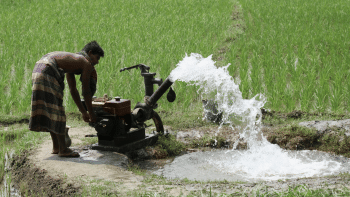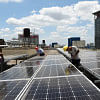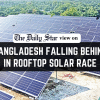Energy-poor Bangladesh and its transition obligations

The 2015 Paris Agreement intended to hold the increase in the global average temperature to well below 2 degrees Celsius above pre-industrial levels and pursue efforts to limit the temperature increase to 1.5 degrees Celsius above pre-industrial levels. Bangladesh, being a tier three country with low CO2 emission, limited land, and climate vulnerability, has no obligations in this regard. In terms of total emissions, as of 2016, China, the United States, and India held the top three positions, emitting 50 percent of CO2. Bangladesh held the 48th position in total emissions, contributing only 0.21 percent. Yet, we have committed to unconditionally reduce our CO2 emission by 6.73 percent by 2030 (using 2012 as the base year). Although our power sector is the major polluter, there is scope for CO2 emission reduction in industrial processes and product use (IPPU), Agriculture, Forestry and Other Land Uses (AFOLU), and waste.
The other international commitment includes the Sustainable Development Goals (SDG), which were set in the UN Conference on Sustainable Development in 2012, with 17 goals for different sectors. The main objective of SDG 7 is to "ensure access to affordable, reliable and sustainable modern energy for all" and was set to be achieved by 2030.
Now, any country using less than 1,000 kWh per capita of modern energy each year is usually considered energy-poor. Spending more than 10 percent of household income on energy bills creates poverty as well. In 2022, 77 percent of the population didn't have access to clean fuel for cooking. Against a global average per capita electricity use of 3,204 kWh per year, the figure for Bangladesh is 464 kWh. By all definitions, Bangladesh is suffering from severe energy poverty.
The country's aspiration is to reach an installed capacity of 60 GW by 2041, with the clean energy target being 40 percent. Currently, 99 percent of energy in the country is produced from fossil fuels, despite around 600 MW of solar installation.
Installed capacity (MW) and energy produced (MWh) from that capacity are two different things entirely. The 24 GW of clean energy will have a maximum of 5 GW of nuclear power that is capable of producing at least 4 GW for 24 hours all year round. The remaining 19 GW of solar and wind can produce energy for a maximum of six hours at varying capacities. Even if we have cheap storage by 2041, the system will require four times more renewable capacity to serve electricity 24 hours. Of course, the grid integration of renewables is much more complex and requires high flexibility of storage (heat, water, battery, hydrogen), demand management (including interruptible large consumers), regional interconnectivity, smart grids, distributed systems not connected to the grid, load shifting, an energy-only market (instead of a capacity market), and some fossil on stand-by. Before proposing the large renewable rollout, the system operator must be consulted for a clear vision and plan. We don't even have an independent system operator (ISO). Jumping on the renewable bandwagon may create a worse mess than what we have with the rental power plants.
Bangladesh recently achieved 99 percent electricity connectivity, which is remarkable and partially meets SDG 7 (except modern fuel for cooking). But with frequent interruptions, load shedding, and voltage fluctuation, this coverage is not reliable. Affordability is being somewhat ensured with heavy subsidies. While the average production cost in 2019-20 was about Tk 6 per kWh, in 2022-23 it went up to almost Tk 12 per kWh. With the average selling cost at the bulk level at Tk 6.7 per kWh and to general customers at Tk 7.5 per kWh, this is simply not sustainable. Providing affordable and sustainable primary energy is the biggest challenge for the country. Currently, around 60 percent of energy for power production is imported. The current import-dependent energy mix was planned in hopes of robust economic growth, which did not materialise. As a result, the energy sector has become a major burden for the foreign exchequer.
With the current grid capacity and additional projects (for energy from coal, nuclear, and LNG) Bangladesh in 2027 (as per the Bangladesh Power Development Board plans I have seen), we will have about 12,000 MW of base load (from imports, coal, and nuclear), 8,000 MW of intermediate load (combined cycle power plant and some simple cycle gas), and 14,000 MW of peak load (6,000 MW being oil-based and 8,000 MW from gas) capacities. Including hydro and renewable, the total installed capacity will be 36 GW. All base load and newer CCPP plants have at least a 20-year life expectancy. It is expected that most of the oil-based and some old gas plants will be retired by 2027. The winter base and peak load demands now are 7 GW and 11 GW, respectively, and in the summer are 12.5 GW and 16 GW, respectively. The base load needs to be the cheapest energy and the peak has to be the most expensive. All oil-based power plants are meant to serve peak demand and should be operated on an energy basis instead of based on capacity. Unfortunately, we are still operating 2.5 GW oil-based plants for base load. Given the current supply and demand scenario, we can accommodate 2,000 MW to 3,000 MW of renewable energy during the day in our system without any major adjustments.
There will be no short-term solution to Bangladesh's energy woes unless the economy and dollar inflow improve. In the medium and long terms, the country must reduce the import dependency on primary energy. We must explore and exploit all three indigenous energy sources—gas, coal, and renewable energy. I believe that even from the existing reserves, one billion cubic feet of additional production will be possible, and that new gas can also be found. The Power System Master Plan 2016 and the newest Integrated Energy and Power Master Plan 2023 are based on hopes of ambitious economic growth for up to 10 years and beyond. But with so much uncertainty regarding future economic growth and technology development, any detailed planning for beyond 10 years is futile.
A ten-year moving plan, based on integrated resource planning, should be chalked out with local experts to reassess demand forecasts. For the best economic and financial outcomes, a stock assessment of the existing power plants (including those in progress) and a clear plan of base, intermediate, and peak load demands (including seasonal variation) must be drawn up. For future renewable integration, we must increase regional connectivity with exchange flexibility. Serious policy decisions must be taken to shift our evening peak load to the daytime. This may include separate office and school schedules for the summer and winter instead of turning back the clock, mandatory shop closure by 8pm during summer, and many other measures. This is essential for renewable integration.
Renewable development must be deployed with clear planning in consultation with a competent system operator. Last but not least, our voluntary contribution to carbon emissions reduction is adequate. Bangladesh should prioritise achieving the SDG 7 of reliable, affordable, and sustainable energy for its citizens.
Dr M Tamim is professor at the Department of Petroleum and Mineral Resources Engineering in Bangladesh University of Engineering and Technology (Buet).
Views expressed in this article are the author's own.
Follow The Daily Star Opinion on Facebook for the latest opinions, commentaries and analyses by experts and professionals. To contribute your article or letter to The Daily Star Opinion, see our guidelines for submission.

 For all latest news, follow The Daily Star's Google News channel.
For all latest news, follow The Daily Star's Google News channel. 










Comments